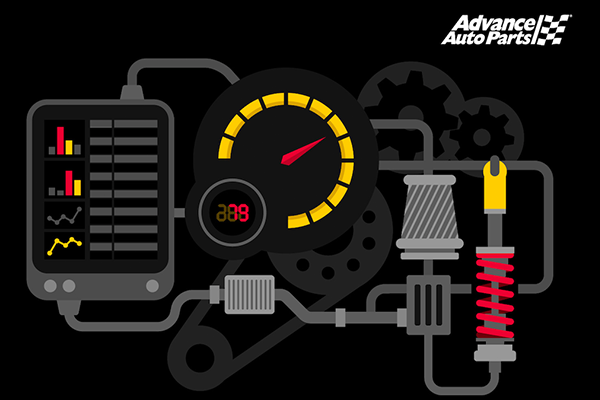Let's say you need a new alternator, brake pads, or any replacement part. At the parts counter, you're offered several choices, from economy parts to the more expensive performance parts. We've explained before how aftermarket parts are just as high quality as original equipment manufacturer (OEM) parts, and are sometimes even the exact same parts. But, today, we're taking a look at why there's a price difference for performance parts, and why you might want to buy the high-performance upgrades vs. saving money with economy parts.

Source | Advance Auto Parts
Alternators
So you just found out your Ford Mustang's alternator is showing signs of failure. Searching online, you easily find 130 amp and 200 amp versions for the same car, with a price difference. Which one do you get? That depends on your needs. Don't worry about overdoing the amps here, as you can't. The electrical components in the car will only get the power they need to operate, whether you have an 85 amp or 300 amp alternator.
If you do a lot of idling in urban traffic, say as an Uber driver, a high output alternator can help prevent undercharging the battery. If you are an off-roading enthusiast, the extra lights, winch, and other accessories create more demand on the electrical system, so go high output. Extreme audio type? Every 100 watts in your sound system draws 16 amps, so go high output. Note that if you increase your electrical draw, a high amp alternator is not the single solution. Be sure to swap out for thicker-gauge cables at the same time to prevent overheating the wiring. Finally, if you're replacing the alternator in a regular daily driver, why risk undercharging? Get the upgraded alternator to fully charge the battery, and run optional accessories you might install down the road.
Brake Pads and Rotors
We've covered the differences in brake pads here, but here's a look at OEM and performance brakes. Economy brake pads and rotors are designed to meet the minimum safety requirements while being as cheap as possible to produce. That's likely to be reflected in their stopping performance, resistance to brake fade, and longevity.
Performance brake rotors are designed to handle aggressive driving or even race-track abuse and heat. That's why many of them feature cryogenic treatments in the forging process and have slotted and/or drilled rotor surfaces that stay cooler during extended use. Staying cooler, whether on a track day or going down a steep mountain grade, means less brake fade during hard use. Performance pads use a different compound than economy pads to deliver more “bite" to the rotor. The one downside to performance brakes is they usually create more brake dust than replacement or economy pads. That is easily remedied with wheel and brake cleaners.
Now you're probably wondering if you should get the performance brakes next time. If you're driving a lightweight car like a Toyota Yaris or Mazda Miata through flat Kansas back roads, you're safe with a more economical choice. However, if you tow, drive through mountainous regions, or do any type of high-performance driving, get the performance pads and rotors for cooler, more consistent braking.
Source | Advance Auto Parts
Catalytic Converter and Exhaust
Exhaust parts are usually one of the first upgrades owners perform when upgrading their ride for more power. Performance exhaust pieces are designed for better flow and less back pressure than OEM parts, enabling the engine to make more power since it doesn't have to work hard to push the spent exhaust gases out of the system.
If your catalytic converter fails, you need to replace it before it leads to more damage. If you have zero interest in vehicle performance, or no plans to modify your daily driver, save some cash and get the OEM catalytic converter. They'll meet emissions requirements for a reasonable price.
If you want a little bump in performance, though, go with a high-performance exhaust. A performance catalytic converter does cost a bit more, but also meets or exceeds emissions standards and will pass state emissions and visual inspections. Muscle car and sports car drivers, or those who are looking to add more power for towing, will want to spend a bit more on the high-performance exhaust so it's not a choke point down the road.
Oil and Oil Filters
There are a few differences between conventional and synthetic oil, but also some differences between store brand and the pricier performance brands. RedLine, Mobil 1, Royal Purple and Liqui Moly all have their dedicated fans, despite the bump in price over the store brand or non-brand oils. Here's an in-depth look at conventional vs. synthetic oils, but in summary—synthetic can handle a wider range of temperatures and longer oil-change intervals.
There's a big difference in oil filters, too. On the cheapest end, the internal paper screening inside the filter lasts for the minimum 3,000 miles before clogging and letting unfiltered oil bypass it. Given today's longer service intervals (some manufacturers recommend 7,500- or even 10,000-mile oil changes), you need a filter that can last the duration. A long-life or premium filter features a cellulose and synthetic filter element that captures almost all of the particles suspended in your oil, and can do so for an extended amount of miles.
Odds are, you should be using a high-quality synthetic oil. Maybe you let the miles roll a bit further past the next scheduled oil change, or your driving conditions might meet the severe service schedule. With the increased protection offered by high-performance oils, protection to the most expensive component of your vehicle—the engine—and a very small cost increase, it makes sense to get the high-performance oil and oil filter every time, no matter what or how you drive.
Source | Advance Auto Parts
Shocks and Struts
Shocks and struts wear out through repeated compression and expansion cycles of the internal gasses. The OEM parts do a solid job of limiting suspension travel caused by bumps in the road, allowing stable on-road handling. Performance suspension parts can offer increased grip on-road sport applications or improved stability during off-road adventures. Quality-wise, they are just about the same pieces, meaning a performance shock/strut likely won't last longer, but it will make the driving experience better.
If you want a factory-quiet and smooth driving experience, then you're okay with the OEM or economy suspension parts. If you drive a sports car or muscle car with all factory OEM parts, and you're looking for just a bit more fun in your drive, opt for the performance suspension parts.
Source | Advance Auto Parts
Spark Plugs
Speaking of upgrades, one of the common first improvements new owners make to improve or tune-up a new-to-them used car is to change out the spark plugs for a premium set. There's a few main types of spark plugs. Standard copper spark plugs ignite the air/fuel mixture at precisely the right time, and they do so with cheap copper cores and nickel alloy tips. Copper plugs seem to last 10,000 to 20,000 miles. Premium plugs have a platinum or iridium tip, which are more durable materials that take the heat and forces of the combustion process. There are stories of iridium spark plugs lasting over 100,000 miles. (Don't do that. Follow your recommended service interval).
Performance plugs cost more, but are they worth it? Like most things, it depends on your situation. Replacement copper plugs are perfectly fine in a factory stock daily driver if that's what your vehicle came with. Step up to platinum if your vehicle is stock, but you don't want to change the spark plugs again for a long time. Iridium rounds out the top of the price range, but they should last the longest under demanding driving conditions, up to 100,000 miles. And remember that it's always okay to move up to a higher-quality spark plug, but don't downgrade if your vehicle came with the better OEM spark plugs. Best bet, check your manual, and get the best spark plugs for your budget. That way you can spend less time wrenching and more time driving.
Have you made upgrades to performance parts in your ride? Tell us about it in the comments.










